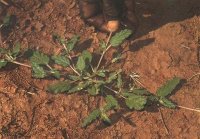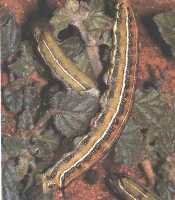
Urpa - Tar Vine
photo Tim Low
Urpa
or Tar Vine (Boerhavia coccinea)
is a low groundcover commonly found in both sandhill and breakaway country of the arid
zone. It has hairy, triangular leaves and small white, purplish or pink flowers. The stems
can run for up to three metres along the ground, and are very sticky, especially the young
tips.
The carrot-like tuber of this plant is an
important food in bad years as it is available even when other plant foods are not. The
root, tasting like parsnip, is baked and the tough outer skin removed before eating.
Anumara
Celerio lineata livornicoides Hawkmoth
Caterpillar

Anumara - Hawkmoth Caterpillar
photo Tim Low
Another important food found on the Tar
Vine is the Anumara (Hawkmoth Caterpillar) (Celerio lineata livornicoides). It
has a greenish and reddish-brown body with black and cream spots and stripes, and a
distinctive black tail spike. These caterpillars eat the leaves of the Tar Vine. When
gathered they are stored for approximately one day so all the eaten plant material is
passed through, yandyed to remove the dung. Alternatively they can be prepared quicker by
removing the head and squeezing the stomach contents out. Anumara
are cooked by adding hot ash to a dish with the caterpillar and gently shaking.
They taste somewhat starchy and can be stored for a long time.
Another use for Urpa
is as a trap for small game birds such as finches. The sticky young growing tips are
spread around small waterholes where these birds come to drink. The birds get entangled in
the vines and are easily captured. This is a common method used by children. |